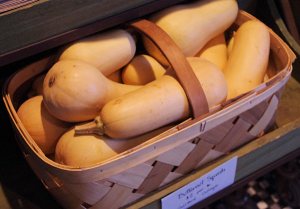A lucky garden: Get started now to have your own garden and market this summer
We asked our favorite farmers for the best tips on prepping the spring garden in February. From the state’s Extension Agent Karen Neill to our own resident farmer Mark Schicker, all were happy to share their best tips with you. And judging by the weather report, things may stay pretty soaked for a little while; plenty of time to sit inside and plan this year’s garden.
Your local county extension office can help you with soil tests, and provides free classes and information – including a monthly planting calendar – to start your own garden. Visit the North Carolina State University Web site, www.ces.ncsu.edu. Offices are listed by county.
Find your local county center
Wake County Extension Office (919) 250-1100
Guilford County, (336) 375-5876
Karen Neill
Extension Agent, Agriculture – Urban Horticulture at North Carolina State University
Gardeners spend their lives trying to improve their soil — because we know that good soil is the foundation to a productive, prosperous garden. Here in the Piedmont, we tend to have a very high clay content that makes our soil extremely sticky when it rains.
Consider the following soil prep tips:
- Make sure not to work your soil when it is too wet. The soil should crumble in your hand versus rolling in a ball.
- Adding organic matter is key. Compost, well-rotted sawdust, and leaf mold are just a few examples. Add a four to six-inch layer of organic matter to the existing soil and till in thoroughly. Organic matter loosens the tight clay particles allowing air, water and roots to move through the soil.
- A soil test is also extremely important in finding out your pH as well as nutrient levels. Contact your county Extension office for information and assistance on soil testing.
- If the soil is too soggy, consider raised beds. I am a big fan of raised beds for just this very fact. Using raised beds, you can get a jump on the garden season versus your friends trying to garden in the heavy clay of the Piedmont. These beds dry out quickly and are easily accessible.
- Mulching garden beds also preserves soil moisture and keeps down weeds. Vegetable gardens may be mulched with herbicide-free grass clippings, compost, straw, or other easily degradable materials. Use caution with grass clippings or straw, they may harbor weed seed. In fact, it might be best to compost grass clippings first so they don’t mat down preventing water and air from entering as freely.
- It’s not too early to get your vegetable gardens planted. English peas, carrots, leaf lettuce, mustard and radishes should be seeded now.
- Garden centers will also be bringing in transplants for other cool season vegetables such as cabbage and broccoli, and don’t forget those onion sets or certified seed potatoes.
- Warm season vegetables can start to go in after the last frost which is typically around April 15 in the Piedmont. Season extenders can be used if you wanted to try and cheat mother nature.
- Go green. Enroll in the North Carolina 10% campaign. Through this program you pledge to spend 10% of your food budget to eating local foods. You can do this by growing your own but also shopping where locally grown or raised food is sold and/or eating at restaurants that also serve local foods. This program not only keeps dollars here in North Carolina supporting our local food economy but it also cuts down on carbon emissions when food has to be trucked in from hundreds of miles away.
Check out the Guilford County Extension web site for upcoming gardening classes: www.guilfordgardenaswers.org

Korey Erb
Guilford College’s Rock Star Farmer
- Make plans. This is the time for making plans. Well-considered plans can often be the difference between a profitable farm and one treading water. Aggregating (or compiling) notes from the last two years into an Excel spreadsheet will help determine when and where to plant what in the coming months, especially if doubling one’s acreage under cultivation (from one acre to two).
- Succession Planting. New plants are put in every two weeks, in an attempt to lengthen the growing season and hopefully outwit pests in the fields.
- Clean up the greenhouse to prepare for starting summer crops from seed by the end of the month.
- Decide on supplements. Soil reports are coming back, so deciding what supplements to till into the fields when discing under winter cover crops in a few weeks (this winter’s wheat, was easier to manage than last winter’s rye) is done now.

Charlie Headington
Bio-diversity expert and gardener profiled in Carolina Gardener, BackHome Magazine and Our State as well as appearing on local TV. Most recently Charlie co-designed, built and directed the first Edible Schoolyard in North Carolina.
- Landscape with edible plants and herbs. Groow dwarf fruit trees and bushes, herbs, and flowers that attract beneficial insects. See Permaculture books and go to www.ediblelandscaping.com.
- Design your own landscape to reflect your values. Be willing to be different whether in the front or backyard.
- Build and plant a culinary herb spiral near your back door. Keep herbs handy and plentiful. See “Gaia’s Garden” for ideas.
- Start small, close to the house. Plant leafy greens and a few favorites. Plum and fig trees are reliable.
- Practice “no-till” gardening. Feed the worms and let them do the work of turning and fertilizing the soil.
- Plant or keep a “wild” or “sacred” space for all the other creatures.The Wildlife Federation has a program or design your own. Get a hive of bees!
- Eat from your garden during all four seasons. Grow the best food in the world all year long. Read “Four Season Harvest.“
- Supplement your home garden with food from the farmer’s market. Local or “slow” food tastes best and supports your local economy..
- Compost your kitchen waste and even your newspaper. Turn waste into “black gold.” You can even do it indoors with worms.
- Sit back and enjoy the beauty and abundance of nature. Ecological and organic gardening can take less time than you think.
Charlie is hosting an introduction to permaculture class at his home April 27. For more information email Charlie at charlie.headington@gmail.com

Mark Schicker
Lucky 32 Southern Kitchen server and farmer, Shicker’s Acre
- Start Indoors. Garden Peas can be started as early as Valentine’s Day; and by the end of the month, start summer plants indoors, that will be transplanted outdoors.
- Sharpen tools. Now’s the time to get your shovels and shears in good working order.
- Till. Lime and other fertilizers or soil additives need to worked into the soil now.
- Direct seed. Start radishes and kale directly in your garden, in the coming weeks, they can tolerate the temperature swings of winter’s transition into spring.
- Transplant. Weather permitting, transplant winter vegetables that have been started indoors, like cabbage, broccoli, and kohlrabi.
Justin Leonard
Edible Schoolyard Garden Manager and Garden Educator at the Greensboro Children’s Museum
- Have a plan. Look up a planting calendar for our region. There’s a good one here at Southern Exposure.
- Be mindful. As the season progresses some of your plants might start going to seed/flowering–let them go. This is food and habitat for beneficial insects.
- Involve the whole family in planning, planting, tending, and harvesting.
- Invest in drip irrigation
- Stagger planting dates for extended harvest.
- Enjoy! Have a party in the garden!
- Experiment. Plant something new to you. Try an heirloom variety–the growers at the local farmer’s market often have older varieties.
- Mulch around plants to retain soil moisture and keep weeds down.
For more about our seasonal recipes, see our current menu at Lucky 32 Southern Kitchen and our Blog Recipe Index:http://lucky32southernkitchen.com/recipes/







